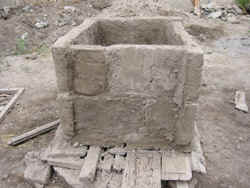
The Moment of Truth
After we gave our plaster time to dry in our adobe box (about 24 hours), it was finally time to fill it with water and see what would happen. Well, we got the hose out and turned it loose leaving for only a minute to grab a note pad. The second we came back water was flowing on the ground, and for a second we thought, "What is going on?" Yep, it was leaking already, before it had a chance to even fill with water! The problem was not with the adobe itself, but with the clay molding we used to bind the adobe bricks together and also our earthen plaster. Since both the plaster and the molding were made mostly out of mud and clay, the material simply disintegrated in the water. Darn! We thought of plastering our adobe box with actual cement or some mixture of cement and natural plaster. However, we know that this could work really well right after construction, but with time small cracks in the cement will also cause leakage.

Where Are We Now?
From our observations we are unable to determine if adobe bricks can in fact hold water because our experiment failed with our plaster and molding. Our hypothesis is that adobe could in fact hold water given an appropriate water-proof binding. In addition, it may be a good idea to try to add some sort of water-proof solution to the adobe bricks themselves to protect the outside surface exposed to the earth and the inside surface exposed to water from long term degradation. We have not yet found the solution to an alternative to fossil fuel based holding reservoirs, but we are one step closer. Not only are we experienced in making and building adobe, we know what does not work and have some ideas about what may work in the future.
Some Options...
There are many things we could experiment with in the future to try and weather-proof adobe and or the plaster and molding that will hold it all together. Some of our ideas, some of which could be combined, include the following: